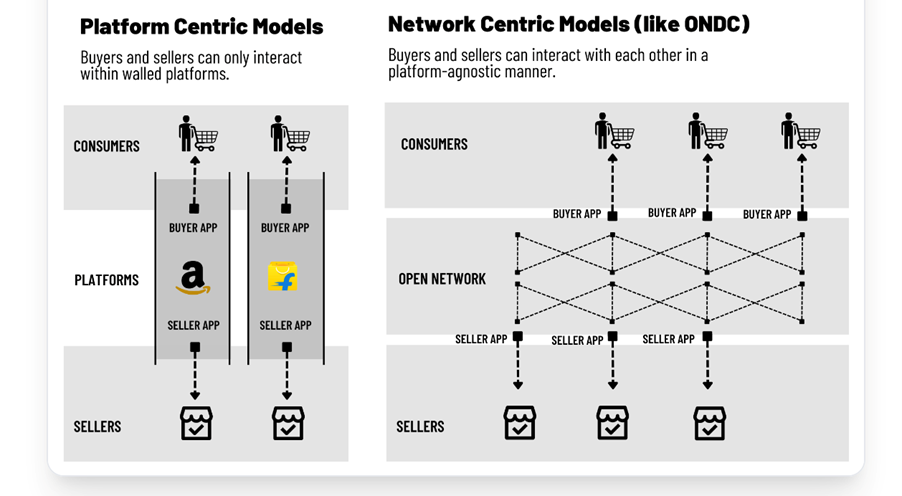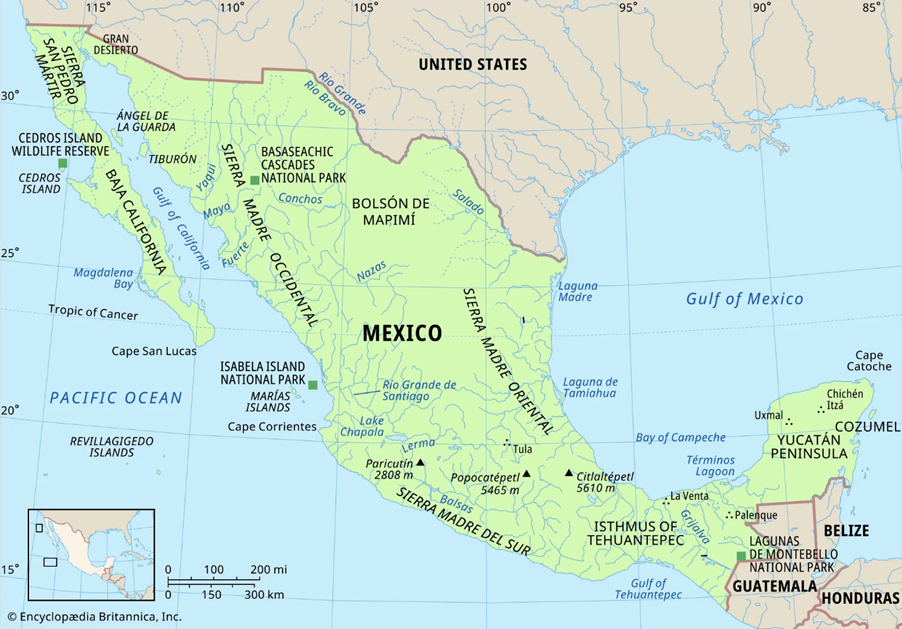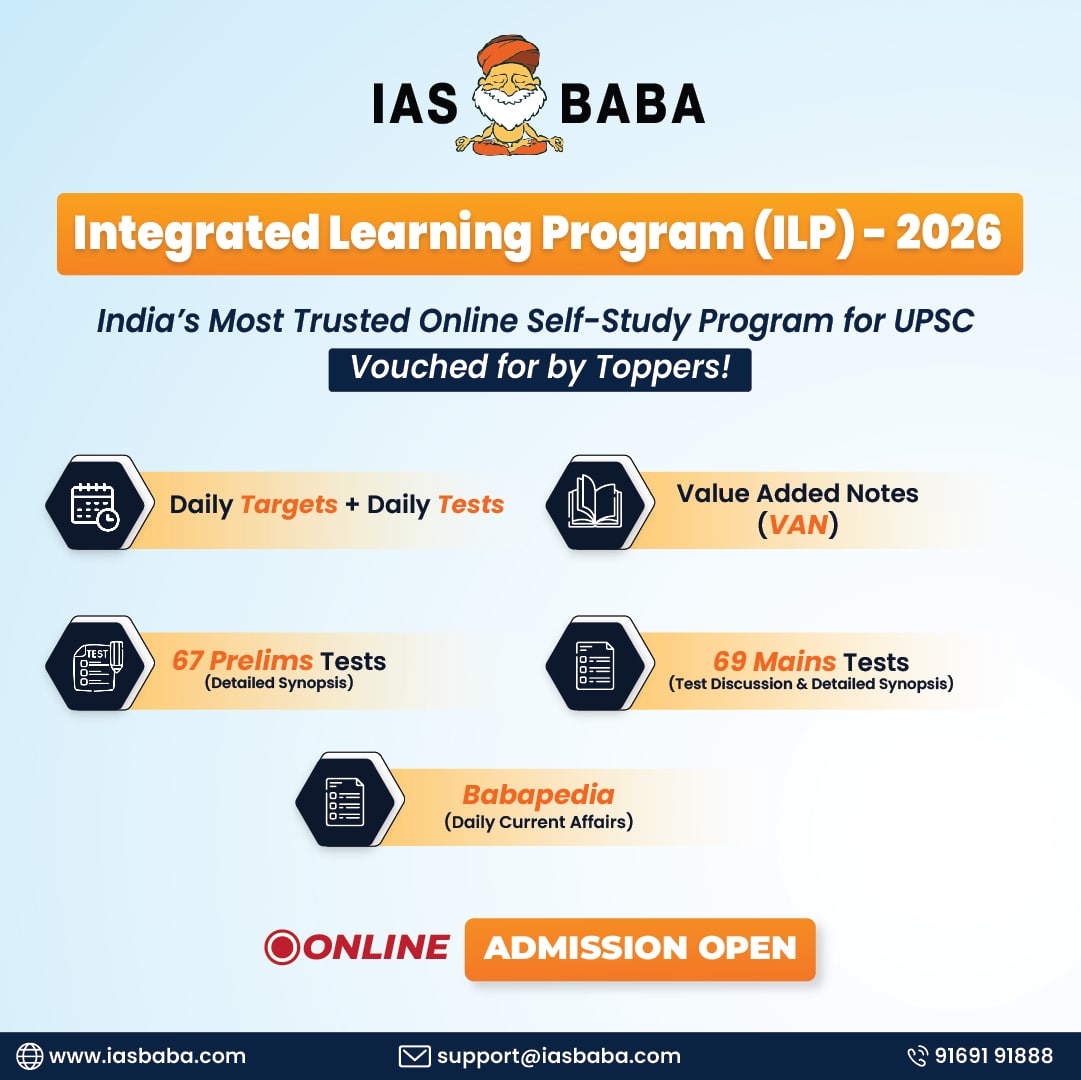IASbaba's Daily Current Affairs Analysis
Archives
(PRELIMS & MAINS Focus)
Syllabus
- Prelims – CURRENT EVENT
Context: The government-backed Open Network for Digital Commerce (ONDC) recorded an all-time high of 8.9 million transactions across retail and ride-hailing segments in May. This represented a robust 23 per cent month-on-month increase in total transaction volume, the ONDC said.
Background:-
- The Open Network for Digital Commerce (ONDC) is a government-backed initiative in India that aims to create an open and interoperable e-commerce ecosystem.

About Open Network for Digital Commerce (ONDC)
- The ‘Open Network for Digital Commerce’ (ONDC), is a Government of India (GoI) backed technology infrastructure. It is a network-centric model, wherein buyers and sellers can transact irrespective of the platforms/applications they use as long as “platforms/applications are connected to this open network”.
- In simple terms, ONDC is like a digital road network over which different digital storefronts (in the form of buyer and seller apps) can be built. The digital road network aims to enable e-commerce traffic to travel across these different digital storefronts seamlessly, thereby allowing buyers and sellers to transact regardless of the application / platform they use.
- This is a significant departure from existing platform centric models of e-commerce where buyers and sellers can only interact within walled platforms.
- To illustrate, today, a seller on Amazon cannot reach a buyer on Flipkart, and vice versa.
- These walled platforms have increasingly dominated transaction volumes in India’s ecommerce market over the years, and today are able to wield immense power and control over e-commerce supply chains.
- This concentration of power and control has led to harmful behaviour such as self-preferencing by platforms or leveraging data to distort competition, which squarely impacts MSME businesses and the consumer interest. ONDC is GoI’s answer to this market distortion.
- ONDC is expected to make e-Commerce more inclusive and accessible for consumers. Consumers can potentially discover any seller, product or service by using any compatible application or platform, thus increasing freedom of choice for consumers.
- It will enable the consumers to match demand with the nearest available supply. This would also give consumers the liberty to choose their preferred local businesses. Thus, ONDC would standardize operations, promote inclusion of local suppliers, drive efficiencies in logistics and lead to enhancement of value for consumers.
- ONDC was incorporated as a Section 8 (NON-PROFIT) company in December 2021, with the Quality Council of India and Protean eGov Technologies Limited as Founding Members.
- Various public and private sector entities have invested in ONDC, including Punjab National Bank, State Bank of India, Axis Bank, Kotak Mahindra Bank, BSE Investments, Central Depository Services, ICICI Bank, and the Small Industries Development Bank of India.
- It is important to note that the relationship between the GoI and ONDC is not legally defined and it does not flow from an act of parliament.
Source: Internet freedom foundation
Syllabus
- Prelims – ECONOMY
Context: Between April-end 2014 and April 2024 – roughly the time the Narendra Modi-government has been in office – the rupee has depreciated by 27.6% against the US dollar, from Rs 60.34 to Rs 83.38.
Background:
- India trades not only with the US. It exports goods and services to other countries as well, while also importing from them. The strength or weakness of the rupee is a function of its exchange rate with not just the US dollar, but also with other global currencies.
Key takeaways
Appreciation of the Rupee:
- When the Rupee appreciates, it gains strength against the Dollar. This means you need fewer Rupees to buy a Dollar. For example, if the value of 1 USD decreases from ₹75 to ₹70, this change is termed as an appreciation of the Rupee
Here are some impacts of Rupee appreciation:
- Exports: Rupee appreciation affects exporters negatively as they may lose importers because they find imports from India more costly.
- Imports: Importers can import more quantity at a less price. This is because they need fewer Rupees to buy a Dollar.
Depreciation of the Rupee:
- When the Rupee depreciates, it loses strength against the Dollar. This means you need more Rupees to buy a Dollar. For example, if the value of 1 USD increases from ₹70 to ₹75, this change is termed as depreciation of the Rupee.
Here are some impacts of Rupee depreciation:
- Exports: Exporters stand to gain the most from Rupee depreciation as it makes exports more competitive.
- Imports: Imports will become costly. This is because importers need more Rupees to buy a Dollar.
- Inflation: The biggest impact of a weakening Rupee is inflation, given India imports more than 80% of its crude oil. This is because the cost of imported goods increases due to a reduction in the value of Rupee.
- IT Sector: The Indian IT sector, which focuses heavily on exports, can achieve more revenue from their global clients due to the decline of the Rupee value.
- Remember, the appreciation and depreciation of the Rupee are strongly influenced by the change in demand or supply for the Rupee and the Dollar.
Source: Indian Express
Syllabus
- Prelims – ECONOMY
Context: The Preston curve refers to a certain empirical relationship that is witnessed between life expectancy and per capita income in a country. The average per capita income of Indians rose from around ₹9,000 per year in 1947 to around ₹55,000 per year in 2011. During the same period, the average life expectancy of Indians rose from a mere 32 years to over 66 years.
Background:
- The empirical relationship was first proposed by American sociologist Samuel H. Preston in his 1975 paper “The changing relation between mortality and level of economic development”.

About PRESTON CURVE
- The Preston curve is an empirical relationship between life expectancy and real per capita income. It is named after Samuel H. Preston who first described it in 1975.
- Preston studied the relationship for the 1900s, 1930s and the 1960s and found it held for each of the three decades.
- Preston found that people living in richer countries generally had longer life spans when compared with people living in poorer countries. This is likely because people in wealthier countries have better access to healthcare, are better educated, live in cleaner surroundings, enjoy better nutrition etc.
- When a poor country begins to grow, its per capita income rises and causes a significant increase in life expectancy initially as people are able to consume more than just subsistence calories, enjoy better healthcare etc.
- However, the positive relationship between per capita income and life expectancy begins to flatten out after a certain point.
- In other words, an increase in the per capita income of a country does not cause much of a rise in the life expectancy of its population beyond a point, perhaps because human life span cannot be increased indefinitely.
Problems in the curve
- The positive relationship highlighted by the Preston curve holds true not just when it comes to life expectancy and per capita income.
- Other development indicators such as infant and maternal mortality, education, healthcare, etc. also improve when the per capita income of a country rises.
- Experts, however, have disagreed over the causal relationship between income levels and human development indicators.
- Many economists have used this positive relationship to argue that the way to improve development outcomes in a country is to encourage economic growth.
- The rapid economic growth of India and China over the last few decades, which has helped improve life expectancy and other development indicators, has been cited as an example of faster economic growth leading to better development outcomes.
- Other experts, meanwhile, have argued that most improvements in life expectancy have come from a shift in the Preston curve rather than due to a movement along the curve. That is, higher life expectancy has been achieved by countries even at low per capita income levels.
- Such improvement in life expectancy at low income levels, according to these experts, could be due to improvements in medical technology, such as the development of life-saving vaccines.
- So, in this view of the Preston curve, improvement in life expectancy and other development outcomes is seen as the result of public investment in human development.
- Critics of this view however, argue that technological advancement itself is linked to income levels; richer countries tend to possess better technologies.
- It should also be noted that poor countries can benefit from technologies that have already been developed by richer countries. They may thus be able to achieve higher life expectancy even at very low levels of income, thus providing a boost to their development indicators despite their low income levels.
- Richer countries, on the other hand, may not have possessed the same life-saving technologies when they were very poor. Hence, their life expectancy may have been far lower when they were poor than poor countries today which have the benefit of technology transfers from countries that are already rich.
Source: Hindu
Syllabus
- Prelims – GEOGRAPHY
Context: Claudia Sheinbaum was elected as the First Female President of Mexico.
Background:
- Sheinbaum will represent the left-leaning National Regeneration Movement (Morena) party when she takes office on October 1.

About MEXICO:
- Mexico, officially the United Mexican States, is a country in the southern portion of North America.
- It is the world’s 13th largest country by area; with a population of almost 130 million, it is the 10th most populous country and has the most Spanish speakers in the world.
- It is the third largest country in Latin America, after Brazil and Argentina.
- Mexico is organized as a federal constitutional republic comprising 31 states and Mexico City, its capital and largest city, and among the world’s most populous metropolitan areas.
- The country shares land borders with the United States to the north, with Guatemala and Belize to the southeast; as well as maritime borders with the Pacific Ocean to the west, the Caribbean Sea to the southeast, and the Gulf of Mexico to the east.
- More than half of the Mexican people live in the centre of the country, whereas vast areas of the arid north and the tropical south are sparsely settled. Migrants from impoverished rural areas have poured into Mexico’s cities, and nearly four-fifths of Mexicans now live in urban areas.
- The stretch of land called the Yucatán Peninsula juts into the Gulf of Mexico from Mexico’s southeastern tip. It was once the home of the Maya civilization.
- Mountains cover much of Mexico. Between the Sierra Madre Oriental mountain range in the east and the Sierra Madre Occidental in the west lie small mountain ranges on the Central Plateau. These regions are rich with valuable metals like silver and copper.
- Mexico is located in one of the Earth’s most dynamic tectonic areas. It is a part of the circum-Pacific “Ring of Fire”—a region of active volcanism and frequent seismic activity.
- Mexico is situated on the western, or leading, edge of the huge North American Plate, whose interaction with the Pacific, Cocos, and Caribbean plates has given rise to numerous and severe earthquakes as well as the earth-building processes that produce southern Mexico’s rugged landscape.
Source: The Wire
Syllabus
- Prelims – ECONOMY
Context: ‘Greedflation’ caused more than half of last year’s inflation surge in US, study finds, as corporate profits remain at all-time highs.
Background:
- Corporate profits drove 53% of inflation during the second and third quarters of 2023 and more than one-third since the start of the pandemic, the report found.
What is inflation
- To begin with, inflation (or the inflation rate) is the rate at which the general price level rises. When it is reported that the inflation rate was 5% in June it implies that the general price level of the economy (as measured by a representative basket of goods and services) was 5% more than what it was in June 2022.
What causes inflation?
- For the most part, there are two main ways in which inflation happens. Either prices get pushed up because input costs have risen — this is called cost-push inflation — or they are pulled up because there is excess demand — this is called demand-pull inflation.
What is the wage-price spiral?
- If prices go up, it is natural that workers will ask for higher wages. But if wages go up, it only fuels the overall demand, while doing nothing to boost the supply. End result: inflation surges further because while a worker has more money, so does his colleague. When they go to the market then the only thing that changes is the price of the good — in other words, inflation rises.
- But what if prices were going up not because workers were getting higher wages but because their masters — the companies — were making more profits?
What is Greedflation
- Greedflation simply means (corporate) greed is fuelling inflation. In other words, instead of the wage-price spiral, it is the profit-price spiral that is in play.
- In essence, greedflation implies that companies exploited the inflation that people were experiencing by putting up their prices way beyond just covering their increased costs and then used that to maximise their profit margins. That, in turn, further fuelled inflation.
- In the developed countries — in Europe and the US — there is a growing consensus that greedflation is the real culprit.
Source: Indian Express
Syllabus
- Mains – GS 3
Context: The Principal Scientific Adviser (PSA) to the Government of India recently convened the first meeting to discuss biomass cultivation on degraded land for green biohydrogen production and bioenergy generation.
Background:
- Biomass Cultivation on Degraded Land: It refers to the practice of growing organic matter, such as crops or trees, on land that has been rendered unsuitable for conventional agriculture due to factors like soil erosion, salinisation, or deforestation.
Significance/Benefits of Biomass Cultivation on Degraded Land:
- The cultivation of energy crops helps rebuild the soil on degraded land and helps improve soil quality, fertility, and structure.
- It prevents soil erosion and creates a habitat for native plant species. This restoration process improves overall biodiversity and provides additional carbon sinks, aiding in the fight against climate change.
- Biomass plants absorb carbon dioxide from the atmosphere during photosynthesis, contributing to climate change mitigation.
- Biomass can be used as a feedstock for green biohydrogen production through a process called thermochemical or biochemical conversion. Green biohydrogen is a clean-burning fuel that produces water vapour as its only emission.
- By growing specific bioenergy crops on previously degraded or barren land, we can harness their biomass for energy production. These crops include fast-growing trees, grasses, and other plants that have high energy content. The biomass can be converted into various forms of energy, such as biofuels, biogas, or solid biomass.
- By focusing biomass cultivation on degraded or marginal lands, it avoids using fertile agricultural land, which is better suited for food crops. This approach helps prevent the diversion of food grains and improves food security while also promoting agri-export.
Challenges/Issues in Biomass Cultivation on Degraded Land:
- Degraded land often lacks essential nutrients and organic matter. Rehabilitating soil quality is crucial for successful biomass cultivation.
- Selecting appropriate biomass crops that can thrive in harsh conditions is challenging. Research is needed to identify resilient species and improve their adaptability. Degraded land may experience extreme temperatures, droughts, or floods.
- Degraded land often lacks adequate water resources. Developing efficient irrigation methods for biomass crops is essential. Exploring rainwater harvesting techniques can enhance water availability.
- Initial investments in land preparation, seedlings, and infrastructure can be high. Biomass crops must align with market demand for bioenergy or other products.
- Governments can encourage farmers through financial incentives. Ensuring economic viability while rehabilitating land is complex.
- Introducing biomass crops may affect local ecosystems and biodiversity. Some biomass crops may become invasive and disrupt native flora and fauna. Implementing cultivation methods that minimise ecological impact is essential.
Way Forward:
- Implementing strategies to improve degraded soil fertility that involves incorporating organic matter like compost, and biochar, or using techniques like biofloculation (harnessing microbial processes) to improve soil health.
- Implementing a multi-tiered cropping system on degraded land, integrating fast-growing tree species with native grasses and legumes. Trees like Pongamia pinnata (Karanj) can fix nitrogen in the soil, improving fertility for companion crops like drought-resistant grasses suitable for biofuel production. This strategy not only helps in biofuel production but also creates a habitat for native fauna, promoting biodiversity.
- Using drones with multispectral sensors to quickly assess large areas of degraded land, map soil composition, identify potential biomass cultivation areas, and evaluate existing biodiversity.
- Developing markets for biomass and its by-products to ensure economic viability and create a value chain that supports rural livelihoods.
Source: PIB
Practice MCQs
Q1.) Consider the following statements with respect to depreciation of rupee.
- Exporters stand to gain the most from Rupee depreciation as it makes exports more competitive.
- Importers can import more quantity at a less price because of rupee depreciation.
- Higher supply of dollar causes the rupee to depreciate with respect to dollar.
How many of the statements given above are correct?
- Only one
- Only two
- All three
- None
Q2.) Consider the following statements about Open Network for Digital Commerce (ONDC)
- It aims to create an open and interoperable e-commerce ecosystem.
- It is a network-centric model, wherein buyers and sellers can transact irrespective of the platforms/applications they use as long as platforms/applications are connected to this open network.
- ONDC was incorporated as a Section 8 (non-profit) company and is fully owned by Government of India.
How many of the statements given above are correct?
- Only one
- Only two
- All three
- None
Q3.) Consider the following statements about greedflation:
- Greedflation happens when companies try to increase their profit margin.
- It is a direct result of wage-price spiral.
Which of the statements given above is/are correct?
- 1 only
- 2 only
- Both 1 and 2
- Neither 1 nor 2
Comment the answers to the above questions in the comment section below!!
ANSWERS FOR ’ 6th June 2024 – Daily Practice MCQs’ will be updated along with tomorrow’s Daily Current Affairs.st
ANSWERS FOR 5th June – Daily Practice MCQs
Q.1) – c
Q.2) – c
Q.3) – c














